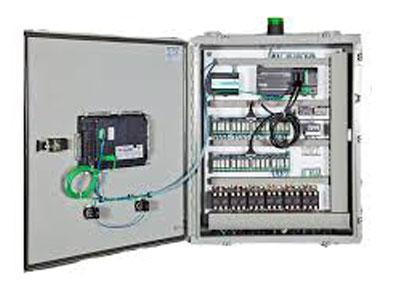How To Test And Troubleshoot Relays In Control Panels?
Key Takeaway
To test and troubleshoot relays in control panels, start with a visual inspection. Look for any loose connections, burned or damaged components, or signs of overheating. This can help identify obvious issues like burn marks.
Next, check the coil resistance using a multimeter. Measure the resistance across the coil terminals and compare it with the manufacturer’s specifications. If the reading is significantly different, the coil might be faulty. Test the continuity by setting the multimeter to continuity mode and touching the probes to the coil terminals. A continuous beep means the coil is intact; no sound means it’s open and needs replacing. Lastly, test the relay’s output contacts with an ohmmeter, ensuring there is no continuity for NO contacts and continuity for NC contacts when the relay is off. Regular testing helps maintain relay performance and prevent failures.
Tools Required for Relay Testing
Testing and troubleshooting relays in control panels require specific tools to ensure accuracy and safety. These tools help identify issues within the relay and ensure it operates as intended. The essential tools for testing relays include:
Multimeter: A versatile tool for measuring voltage, current, and resistance to check the health of the relay coil and contacts.
Relay Tester: A specialized device to simulate relay input signals and monitor output behavior.
Clamp Meter: Used to measure current without direct contact, ensuring the relay circuit’s current flow is within acceptable ranges.
Insulation Tester: Checks for proper insulation, preventing electrical shorts and ensuring the relay’s safety.
Having these tools readily available ensures efficient and safe relay testing. Proper use of these instruments helps identify potential issues early, preventing system failures and ensuring optimal performance.

Identifying Symptoms of Relay Malfunctions
Recognizing signs of a malfunctioning relay is crucial for timely repairs and system reliability. Common symptoms of relay issues include:
Intermittent Operation: If a relay is sticking or not activating as expected, it could be due to wear or contamination of contacts.
No Operation: A relay that fails to activate might have a damaged coil or an electrical issue preventing energization.
Overheating: Excessive heat can be a sign of high resistance in the contacts or a malfunctioning coil.
Noise: Audible clicking sounds during operation may indicate a problem with the relay’s internal mechanism.
Burnt Contacts: Evidence of arcing or pitting on the contacts signals that the relay is unable to properly switch the circuit.
Understanding these symptoms helps diagnose relay problems efficiently and avoid larger system malfunctions.
Testing Relay Coil and Contacts
Testing the relay coil and contacts is an essential part of troubleshooting. Here’s how to perform these checks:
Coil Testing: Use a multimeter to check the resistance across the coil. A healthy coil should show a specific resistance value based on the manufacturer’s specifications. If the reading is zero or infinity, the coil is likely damaged.
Contact Testing: Inspect the contacts with a multimeter set to continuity mode. A normally open (NO) contact should show no continuity when the relay is de-energized and continuity when activated. For normally closed (NC) contacts, the opposite should be true.
Voltage Check: Ensure that the relay coil receives the correct voltage when activated. A drop in voltage may indicate wiring issues or a faulty power supply.
These steps can help pinpoint whether the relay coil or contacts are the source of the problem and guide the necessary repairs or replacements.
Troubleshooting Common Relay Issues
When dealing with common relay issues, a systematic approach helps resolve problems efficiently:
Sticking Contacts: This can be caused by contamination or wear. Clean contacts with contact cleaner or replace if necessary.
Worn or Burnt Contacts: Replace contacts showing signs of wear or damage to ensure proper operation and prevent future failures.
Power Supply Issues: Verify that the relay receives stable power. Fluctuations can cause the relay to fail intermittently.
Coil Damage: Replace the coil if it shows signs of damage, such as burnt sections or an open circuit.
Loose Connections: Ensure all connections are secure and there is no corrosion or loose wiring affecting the relay’s performance.
By following these steps, engineers can minimize downtime and maintain the reliability of control panels.
Preventive Maintenance Tips for Relays
Preventive maintenance is key to extending the life and performance of relays. Here are tips to keep relays in optimal condition:
Regular Inspections: Schedule routine checks to look for signs of wear, corrosion, and overheating.
Clean Contacts: Keep relay contacts clean and free of debris to prevent arcing and ensure proper conductivity.
Avoid Overloading: Ensure relays are not subjected to higher currents than their rated capacity.
Protect from Moisture and Dust: Use protective covers and enclosures to keep relays safe from environmental contaminants.
Test Periodically: Conduct routine testing using a multimeter and relay tester to detect early issues.
Implementing these practices reduces the likelihood of unexpected failures, improves system uptime, and ensures reliable operation.
Conclusion
Testing and troubleshooting relays in control panels is a critical task for maintaining system performance and safety. By using the right tools, identifying symptoms of malfunctions, and following systematic testing and troubleshooting procedures, engineers can ensure relays function properly. Regular preventive maintenance further enhances reliability, preventing potential failures and extending the life of the relay. Properly functioning relays are essential for the smooth operation of control systems, protecting equipment, and maintaining overall safety.

